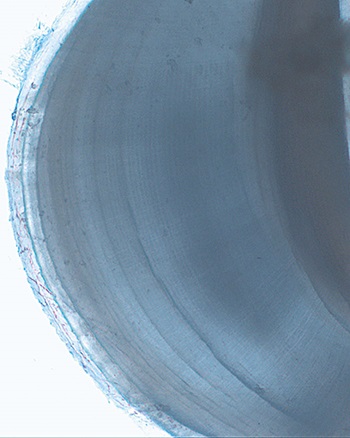 Freediver surfacing with hand-collected Eastern Rocklobster off the coast of Coffs Harbour, NSW. Young NSW researcher Jesse Leland (on board the vessel) has turned his attention inwards to solve the problem of determining a crustacean’s age.
Freediver surfacing with hand-collected Eastern Rocklobster off the coast of Coffs Harbour, NSW. Young NSW researcher Jesse Leland (on board the vessel) has turned his attention inwards to solve the problem of determining a crustacean’s age. Photo: Austin May
By Catherine Norwood
Crustaceans grow by moulting their exoskeletons, which has made it difficult to tell how old they are using traditional ageing techniques. From a fisheries management perspective, a lack of age information also makes it difficult to assess how changing environmental factors may affect growth.
However, researcher Jesse Leland has published details of an innovative ageing technique that uses cross-sectional analysis of gastric ossicles (stomach bones) and other calcified structures. He recently won the FRDC-sponsored 2013 Science and Innovation Awards for Young People in Agriculture, Fisheries and Forestry.
He says the FRDC award will allow him to continue researching invertebrate ageing as his primary area of interest.



“Hopefully, it will be a stepping stone towards other larger projects that will keep Australia at the forefront of crustacean ageing research worldwide, while facilitating continuing sustainable management of our fisheries.
“The idea actually came from my colleague who was fascinated by the usefulness of gastric ossicles in taxonomy,” Jesse Leland explains. “We were pleasantly surprised, when I sectioned some, to find that they contained growth marks. Now the fact that gastric growth records can be retained through moulting has been validated in the scientific literature.”
He says that until recently it was assumed that growth by moulting excluded the possibility of a permanent growth record; only indirect, and somewhat imprecise, methods for age estimation were available.
“Knowledge of age, growth rates and life span is critical for understanding important events in a species’ life history, such as reproductive maturity, entry into the fishery and natural mortality.”
Based at Southern Cross University’s Lismore campus and the National Marine Science Centre at Coffs Harbour, Jesse Leland will use his $16,000 award from the FRDC to apply his ageing methodology to two commercially and recreationally important Australian crustaceans, beginning with Redclaw crayfish (Cherax quadricarinatus) and Mud Crab (Scylla serrata).
“I chose Redclaw as an ideal model species for developing ageing protocols, which can then be applied to Mud Crab. But this is just the beginning. In the future, I hope to age many other Australian crustaceans, starting with the most economically important and potentially long-lived species.”
Jesse Leland expects the protocols will also be extended internationally, especially to long-lived and deep-water species for which even indirect ageing methods are impractical.
“The knowledge obtained from this research will facilitate sustainable management of Australia’s crustacean fisheries, which is of utmost importance to the entire industry.
“One major uncertainty currently facing fisheries managers is how changing environmental conditions may affect crustacean growth rates. But as a prerequisite to this, we must first accurately understand current – ‘normal’ – growth rates. In the future, validated age and growth models will be a valuable tool for monitoring changes among crustacean stocks.”
Jesse Leland is completing his PhD thesis on the physiology, injury and survival of discarded crustaceans in NSW, and preparing scientific publications on determining the age of Australian beachworms. Soon, his research will focus solely on crustacean ageing, and he says he is excited about the prospects for his chosen field, crustacean biology.
Photo captions (from top)
1. Jesse Leland (left) and FRDC chair Harry Woods at the Science and Innovation Awards ceremony in Canberra. Photo: Steve Keough Photography
2. A gastric mill. Recent studies have used them to solve the long-existing problem of crustacean age determination. Photo: Jesse Leland
3. Microscopy image of a sectioned gastric ossicle showing growth marks used for ageing crustaceans.
FRDC Research Code: 2008-339
More information
Jesse Leland, jesse.leland@scu.edu.au





